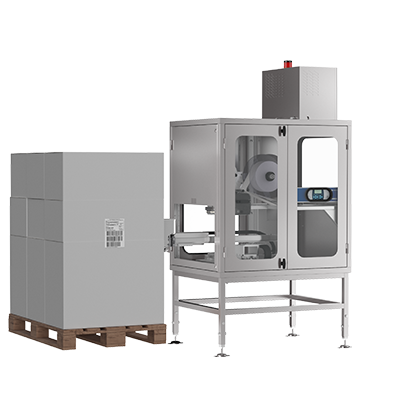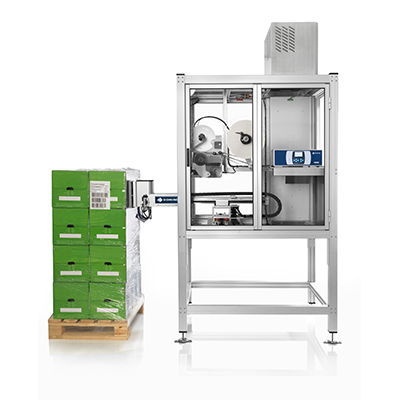Here at Domino North America, we would really hate to over simplify the industry that we've spent 40 years working within and trying to engineer the best solutions, but really, product packaging basically works kind of like a Nesting Doll - one technology fits on top of another and that fits on top of another, etc. Think about it, your tertiary packaging holds your secondary packaging, which in turn holds your primary packaging.
However, unlike those dolls, all three levels absolutely need clean and clear barcode labels - after all, in today's on-demand tracking environment, every product that leaves your production facility is better to be tracked. How does this happen? With a good code, you can get superior product traceability throughout the supply chain all the way to the customer.
As you probably now, Pallet Labeling or is the process of coding your tertiary packaging – most often a pallet – with two or more barcodes so product managers and customers can track their purchases through the entirety of the supply chain.
Now, more than ever, this is an absolute necessity.
What exactly does a pallet code do?
In a nutshell, a pallet label guarantees proper product tracing. With a barcode or QR code, a product can be traced all the way from the production factory all the way to the consumer.
At the store level, in order to keep up with just in time (JIT) inventory - plus the ever-expanding tastes of the end consumer, manufacturers are under huge pressure to step up their traceability game.
How do you do that? Well, label pallets with clear and legible codes containing the following product attributes such as:
- Details of the product
- Product Quantity
- Supplier Details
- Serial Numbers
- Batch Numbers
Superior Traceability, Superior Organization
Why would your organization need this level of data?
Have you ever ordered anything that you really wanted - and tracked its every last movement? That's why.
In business, with JIT inventory and finance managers worrying about the cash flow health of the business, this level of tracking is all the more vital.
Beyond the bottom line, it's also for the traceability purposes for your warehouse or Distribution Center where scanners are used to read said barcodes and QR Codes quickly and without fault.
That's where the 'clear' part comes in - if codes aren't clear, your barcode aren't going to register and your product isn't going to get tracked, affecting warehousing, distribution centers, and yes, your company's bottom line..
In the worst case scenario, even if a batch of product actually ends up at a customer safely, if it doesn't get scanned, it might not exist to your systems and could result in doubling up orders or wasted product.
However, when labels are applied correctly on multiple surfaces, they are easier to find, easier to scan and can enhance logistical efficiency and inventory control - ultimately saving your business time and money.
What are some common pallet coding issues?
For efficient pallet Labeling, labels must be perfectly printed and correctly placed onto each pallet at speed. To reach this efficiency, automating the labeling process is vital.
However, many companies still manually label their stock which can be a highly inefficient and mistake-prone process. For example, warehouse workers might unload a pallet, get off the forklift, walk over to a computer to print off the labels, walk back to the pallet to apply the labels by hand, hop back onto the forklift and move the pallet into storage or onto a lorry for transportation. Does it sound inefficient to you?
This manual method leads to a lot of wasted time that affects final margins. Not to mention, any applications by hand are generally not square and may not meet the GS1 height guidelines, causing further potential headaches in the future.
If a label is in the wrong place and doesn't meet these guidelines, a scanner can't read it. Your stock could therefore get rejected if scanned incorrectly, leading to more time lost and potential fines.
How will a pallet labeler help my organization avoid fines?
The volume of pallets produced requires a labeling system that will print and apply labels correctly every time, keeping production costs down and ensuring goods face no problems throughout the supply chain.
However, GS1 standards aside, perhaps the most critical challenge is ensuring that your labels are compliant with your customers and can integrate with their existing systems. It's vital to know what your customers require and how to label your pallets to suit them efficiently.
As such, you must be versatile in how many labels you apply to the pallet. The GS1 guidelines only show what most customers need. While some may require only one or two, some could need three or more.
To meet most guidelines, you simply have to apply labels in the correct locations, ensuring they are placed squarely and without any uneven edges or creasing. Automating your pallet labeling process will allow for accurate placement each and every time.

What if my production facility has a humid or hot environment?
While it can be a challenge to ensuring clear, uniform labeling, there are many other external factors in the process to consider.
For instance, the environments your tertiary packaging will go through can also affect the labeling process. Packaging in a wet environment will have different requirements compared to a dry environment.
For example, wet beverage sites may need stainless steel cabinets to protect them from the humidity.
Temperature
Temperature can also be an issue, so you may need climate control kits or heaters to ensure that a suitable climate is maintained at all times.
As these labels contain a lot of information, it's essential to consider both yours and your customers' software capabilities. Controls from the pallet labeler to the palletiser must be able to send and receive signals efficiently in order to stop the pallet and move it along once the label is applied. Generally, this information is stored in an Enterprise Resource Planning system (ERP) or Manufacturing Execution System (MES), and it will use the Domino Command 41 protocol or Domino's QuickDesign label design software to integrate together.
The conveyor systems used in the different stages of a pallet's journey may differ in height and speed, as well as the number of stops it makes as it moves through the palletiser and stretch wrapper. As such, a flexible and easily adjustable system is crucial.
To tackle these critical issues and avoid making costly mistakes, you need a versatile pallet labeler that you can configure to meet GS1 and customer standards with ease.
